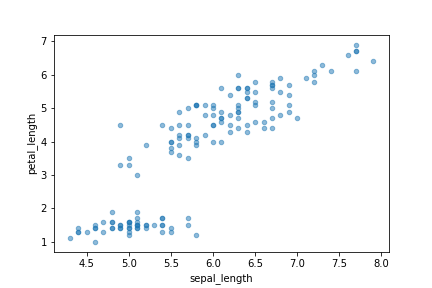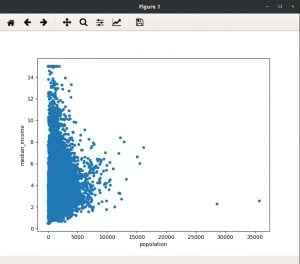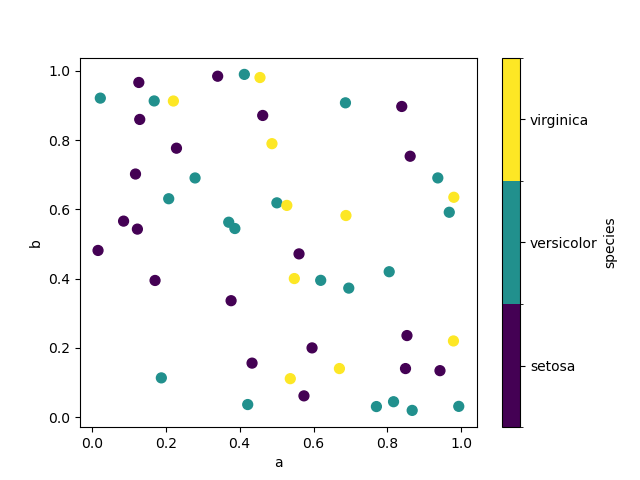
- #Pandas plot scatter title how to#
- #Pandas plot scatter title code#
- #Pandas plot scatter title free#
Notice that the font size in the legend is much larger now. Suppose we have the following pandas DataFrame: import pandas as pdĭf = pd. Following are the quick examples Example 1: create histogram with title df.plot(kind 'hist', title 'Students Marks') Example 2: Create title of individual columns of histogram df.plot(kind'hist', subplotsTrue, title'Maths', 'Physics', 'Chemistry') Example 3: Get the individual column as a bar df'death rate'.plot(kind'bar'). Example: Create and Customize Plot Legend in Pandas
#Pandas plot scatter title how to#
The following example shows how to use this syntax in practice. legend(, loc=' center left', title=' Legend Title') 43 You can use suptitle (): import pylab as pl from pandas import data DataFrame (np.random.randn (500).reshape (100,5), columnslist ('abcde')) axes data.hist (shareyTrue, sharexTrue) pl. You also learned how to control these titles globally and how to reset values back to their default values.You can use the following basic syntax to add a legend to a plot in pandas: plt. You also learned how to control the style, size, and position of these titles. In this tutorial, you learned how to use Matplotlib to add titles, subtitles, and axis labels to your plots. update() method again and pass in the default values: # Restoring rcParams back to default values In order to restore values to their default values, we can use the. Matplotlib stores the default values in the rcParamsDefault attribute. Once you’ve set the rcParams in Matplotlib, you may want to reset these styles in order to ensure that the next time you run your script that default values are applied.

Resetting Matplotlib Title Styles to Default Values If you’re curious about the different rcParams that are available, you can print them using the () method. Plt.ylabel('y-Axis Title', style='italic', loc='bottom') Plt.xlabel('x-Axis Label', fontweight='bold') Let’s see how we can add and style axis labels in Matplotlib: # Adding Axis Labels to a Matplotlib Plot ylabel() adds an y-axis label to your plot

xlabel() adds an x-axis label to your plot We can add axis titles using the following methods: This is part of the incredible flexibility that Matplotlib offers. Matplotlib handles the styling of axis labels in the same way that you learned above. The method lets you pass in a string that represents the title that you want to apply. Axis labels provide descriptive titles to your data to help your readers understand what your dad is communicating. Adding a title to a Matplotlib plot is done using the. In this section, you’ll learn how to add axis labels to your Matplotlib plot. In the next section, you’ll learn how to add and style axis labels in a Matplotlib plot. While this is an official way to add a subtitle to a Matplotlib plot, it does provide the option to visually represent a subtitle. Then, you learned how to customize the color of the chart, add titles and axis labels, change the size of the points, and add multiple different data labels. plot () function to create a basic scatter plot. Y = Īdding a subtitle to your Matplotlib plot In this tutorial, you learned how to use Pandas to create a scatter plot.

Let’s see how we can use these parameters to style our plot: # Adding style to our plot's title The ones above represent the key parameters that we can use to control the styling.
#Pandas plot scatter title code#
Set Up Your Environment You can best follow along with the code in this tutorial in a Jupyter Notebook.
#Pandas plot scatter title free#
There are many, many more attributes that you can learn about in the official documentation. How to discover correlation with a scatter plot How to analyze different categories and their ratios Free Bonus: Click here to get access to a Conda cheat sheet with handy usage examples for managing your Python environment and packages.


 0 kommentar(er)
0 kommentar(er)
